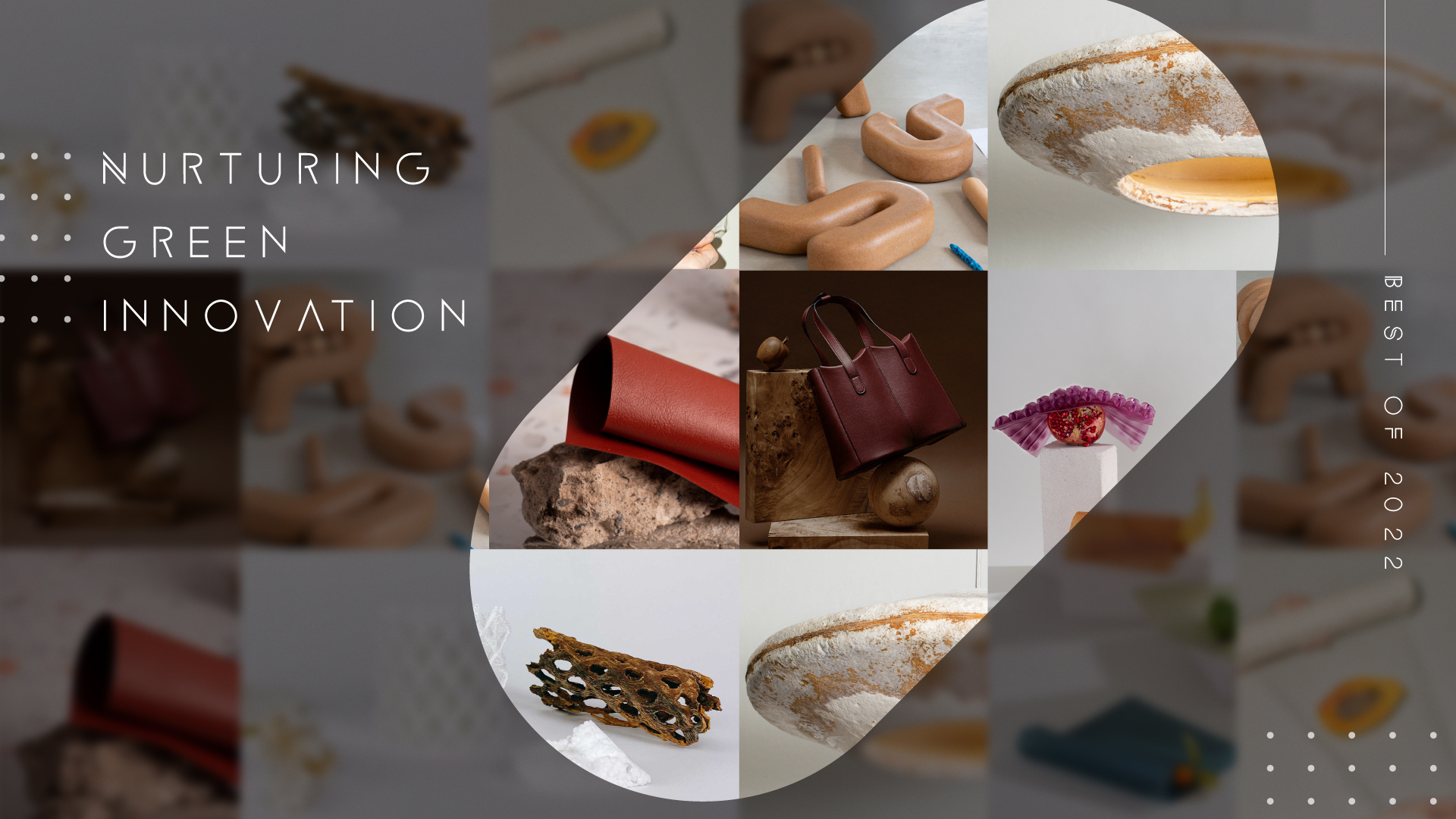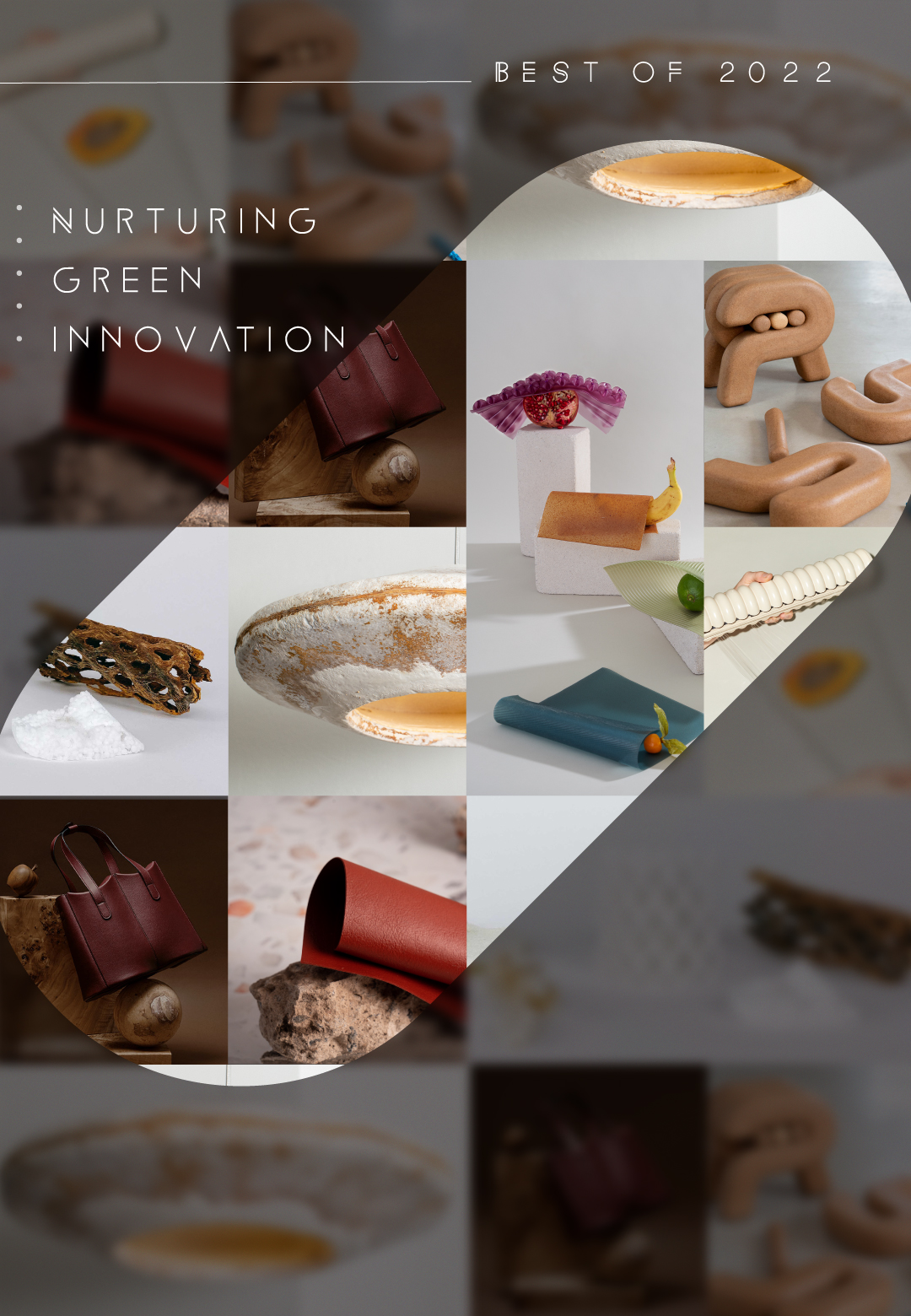As our collective ignorance covertly ushers us into the gaping abyss of ecological imbalance, making amends to established lifestyles and practices is fundamental. Climate change, deforestation, resource depletion and contamination, and unfathomable waste production are a few ramifications of decades of neglectful practices. For years, activists, researchers, and educators have worked tirelessly to raise awareness among global communities, with repercussions visible in the fields of art and design. This year, green initiatives continued to sprout in domains such as furniture design, product design, industrial design and fashion design. Material innovation was a niche that was conspicuously dominated by sustainability movements, with recycled products, upcycled waste, and even microorganism-grown substances replacing conventional materials.
In a time of dire environmental crisis, the design community increasingly turns towards the all-powerful nurturing force of nature. Plant-based biomaterials garnered much attention in 2022 for being potential alternatives to materials that have long harmed the planet. These long-overdue innovations have turned the tide, submerging the creative community in a new wave of mindful design practices, from replacing wood in furniture to dethroning the ubiquitous plastic. STIR has compiled the Best of 2022 in the realm of biomaterials, defining the NEXT in design with a focus on green material development.
Vegan leather by Uncaged Innovations
Leather, specifically animal leather, is as coveted as it is controversial. Many have made exemplary efforts towards concocting a sustainable replacement for the beloved material, only to fall short of the industry’s needs. Founded in 2020 by sustainability expert, entrepreneur, and vegan Stephanie Downs, the New York-based company Uncaged Innovations creates sustainable substitutes for conventional leather without compromising its valued attributes. The company is on a journey of constant innovation to develop cruelty-free and more eco-friendly materials that cater to markets such as home goods, automobile design, and fashion design. Instead of relying on a single source that does not meet all of the criteria, Uncaged Innovations researchers resorted to blending multiple biomaterials to achieve realistic results. The material preserves the unique qualities of leather—strength, stretch, flexibility, smell, and distinctive hand feel—while safeguarding the tenets of sustainability.
Piñatex by Ananas Anam
This pineapple leaf-based product draws inspiration from a traditional Philippine garment made from pineapple leaves, the Barong Tagalog. After visiting the Philippines, Dr Carmen Hijosa, who has worked in the leather goods industry for many years, was appalled at the shocking practices in leather tanneries that demonstrated serious hazardous practices for people and the environment. Responding to the desperate need for alternate solutions, she partnered with local Philippine weavers to experiment and patent a new type of fabric: Piñatex by Ananas Anam, the makers of the innovative textile, founded by Hijosa which is now a Certified B Corporation®. Birthed from salvaged pineapple harvest discards, the material challenges synthetic and virgin-grown textiles whose raw materials are more energy and resource-intensive to produce.
Compostable cling film by Great Wrap
How many times do we come across products that pledge to be eco-friendly yet arrive at the door laden with plastic wrap and packaging? Julia and Jordy Kay, CEOs and co-founders of the Melbourne-based biomaterials company Great Wrap, turned their awareness of the problem into a long-overdue design solution: a sustainable alternative to petroleum-based cling wrap. The company is Australia's first and only manufacturer of a certified home compostable cling wrap derived from potato waste. Great Mate, their latest innovation, is a refillable dispenser for their stretch wrap, made from 33 recycled PET bottles—designed to clothe the cling wrap rolls and ensure their seamless extraction.
Peelsphere by Youyang Song
Innovative design, material science and sustainability come together in Peelsphere, a 100% biodegradable alternative to synthetic leather. Youyang Song, a textile designer and researcher based in Berlin, Germany, aims to introduce new methods, challenge extant norms, and redefine the relationship between materials and sustainability. The vegan leather substitute draws inspiration from the renewability of plants and takes shape through fruit waste and algae. The versatile material that results from a journey of recycling, redesigning, and remanufacturing could potentially replace animal hide while retaining the intrinsic properties of the popular material.
Nontalo Kids by Eneris Collective x NaifactoryLAB
Building sets defy time and age, providing freedom to realise imaginations, build sans the inhibitions of sanity, and embark on an expedition of unending novelty—a constant amidst otherwise transitory product designs. Spanish designers Irene Segarra and Irene Martnez, known as Eneris Collective, inject the spontaneity of playful construction sets into their new stool. Titled Nontalo Kids, the stool design pushes the boundaries of conventional kids’ furniture that often sets itself apart only in terms of size and colour. Eneris Collective collaborates with Barcelona-based biomaterials company NaifactoryLAB to create an evolving stool design made with Reolivar, a compostable material made of olive pits—an amalgam of play, spontaneity, and sustainability.
‘Experimental Gastronomy’ by Steinbeisser
In this immersive feast, food conjured by nature is served in calcareous bowls, plates made out of leaf blades, and spoons and forks built out of twigs—the mundane act of eating morphs into an immersive experience. Experimental Gastronomy by Amsterdam-based Steinbeisser is an initiative that serves as a coalescence of food, design and fantasy. Through this programme, Jouw Wijnsma and Martin Kullik, founders of Steinbeisser, uncover new ways to experience food and ways of feeding oneself. While renowned chefs experiment with spices, vegetables, fruits and meat, among other edible accoutrements, artists and designers collaborating on this project build both experimental and biomimetic cutlery and tableware. All elements interlace into a dining experience that can be savoured and also acquired as souvenirs.
Malala by Nichetto Studio
Nichetto Studio, based in Sweden, delves into the world of fashion accessories with Malala, a medium-sized tote bag that can be carried by hand or on the shoulder. Produced in collaboration with the New York brand Angela Roi, founded in 2012 by the naturalised American designer of Korean origin. Malala is born from apple skin, a vegan fabric partially created with the scraps of apple processing. Apple leather reinstates the value of material otherwise discarded as waste and turns it into new raw resources, lowering energy consumption and emissions in the production chain. With its modern flair and a unique silhouette, Malala embodies elegance, durability and sustainable design, striding towards the goal of inspiring people to make better choices for a better future.
Mycelium-based materials by Myceen
Nature withholds unfathomable intelligence that humankind often turns a blind eye to. Fungi, which have been on the planet for nearly a billion years, have survived and evolved over millennia, demonstrating their advanced forms. Myceen, a sustainable design and research entity based in Tallinn, Estonia, employs a wealth of knowledge to create solutions to problems. Focused on the development of mushroom mycelium-based materials, the biotechnology company began with furniture design and interior products before transitioning to building materials. Mycelium is composed of a network of hyphae that supply nutrients for the fungus, a network that can adhere loose matter into a solid, non-flammable, carbon-negative material with good acoustic properties.
Chitofoam by Doppelgänger
American design studio Doppelgänger, helmed by Charlotte Böhning and Mary Lempres, addressed the rampant plastic waste crisis in their recent material innovation, Chitofoam. The material, analogous to polystyrene foam, is a bioplastic version of the same, made from the exoskeletons of Styrofoam-eating mealworms. Shock-absorbent, water-resistant and impressively versatile, Chitofoam can take the shape of cups as well as different forms of packaging and can decompose easily in a matter of weeks, unlike the infamous plastic it aims to replace. When contemplating the omnipresence of plastic and the role design plays in its mitigation, there is frequent mention of circular design; Chitofoam, conforms to this approach, provides a circular solution for Styrofoam waste management.
Algae-grown limestone by University of Colorado Boulder
Global cement production makes up 7% of annual greenhouse, mostly through the burning of quarried limestone. As carbon emissions increasingly stifle the planet, the University of Colorado Boulder spearheads a research team that has devised an innovative carbon neutral—and even carbon negative—technique to produce cement, by extracting carbon dioxide from the air with the help of microalgae. Calcium carbonate, the main constituent of limestone, is continuously produced in nature in coral reefs and by some species of calcareous microalgae. Nature, posing as a perpetual muse, plants a question in the researchers' inquisitive minds: If nature can grow limestone, why can’t we? The research team was also chosen by the HESTIA program to expand and escalate the production of biogenic Portland-limestone cement and stride towards a zero-carbon future.
Biomaterial innovation is a sight for sore eyes in a milieu of environmentally degrading materials and short-sighted sustainable endeavours. The deep-rooted foundation of norms and conventions cracks one initiative at a time, carving the path to a better, more mindful future.






 Sign in with email
Sign in with email










What do you think?